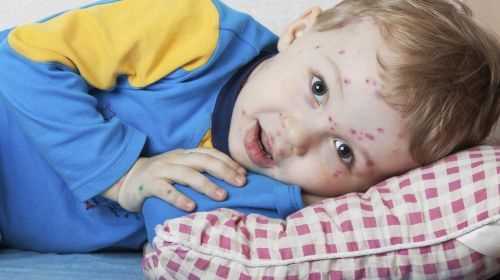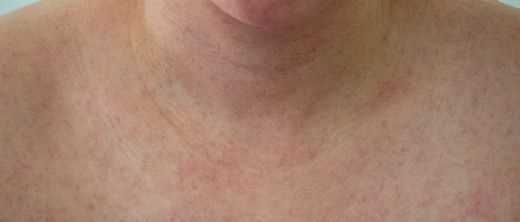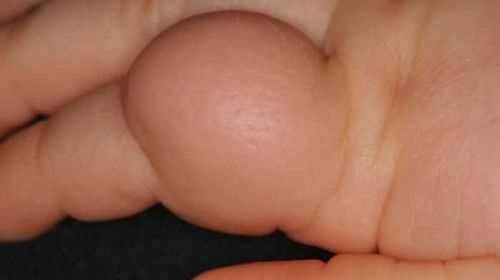Rubella is a very contagious infection caused by viruses. The childhood disease is common all over the world and is particularly problematic during pregnancy. Which symptoms are typical of rubella, why they are dangerous and how the rubella vaccination protects.
The causative agent of rubella, the rubella virus, can be found all over the world. Since most non-vaccinated people develop rubella in childhood and the viruses spread quickly, they are among the classic childhood diseases. Rubella is notifiable in Germany. Since 1980, the Standing Vaccination Commission of the Robert Koch Institute (STIKO) has recommended vaccination against rubella in combination with a vaccine against measles and mumps (MMR vaccination).
Since the vaccination was introduced, major rubella outbreaks have become rare in Germany. Rubella is a particular danger for pregnant women: If an infection with the rubella virus occurs during early pregnancy, there is a high risk of miscarriage and malformations.
Article content at a glance:
Rubella – Symptoms and Signs
A typical symptom of rubella is the blotchy skin rash (rubella rash) in about half of all those affected, which is characterized by numerous light red, small, sometimes slightly raised spots. Rubella rash usually begins on the face and spreads from there over the abdomen and arms to the legs, eventually covering the entire body.
In children, however, rubella runs in 50 percent of cases without any typical signs. The rubella then progresses in a similar way to a flu-like infection, so that the parents of affected children do not even know that their child has rubella. If the disease breaks out, many sufferers initially complain of general symptoms that are more like the flu. Many feel tired and weak, and the lymph nodes in the neck area can swell and hurt. Often coughs and runny nose as well as a slight fever occur.
The rash will go away after one to three days. In most cases the rubella is mild. While infections in childhood often proceed without major problems, the frequency of complications increases with age. If, however, an infection with rubella during pregnancy is high, the risk of serious, sometimes lifelong consequences is high.
Complications and long-term effects of rubella infection
The following complications can occur with rubella:
If a woman who is not immune to rubella becomes infected in the first four months of pregnancy, the following complications can occur:
- Miscarriage
- Congenital rubella embryo fetopathy or rubella embryopathy (CRS) with malformations of the heart, ears or eyes
How is rubella transmitted?
Rubella virus is the cause of rubella. This virus is spread around the world and only affects humans. Rubella is highly contagious, which means that even small amounts of the pathogen are enough to trigger the disease. There are numerous viruses in the mouth, throat and nose of someone infected with rubella. As a rule, the transmission takes place from person to person, for example by coughing or sneezing (droplet infection). The virus is insidious because people with rubella excrete viruses before symptoms appear.
The viruses first penetrate the body through the mucous membranes of the mouth and nose. After the viruses have multiplied in the lymphatic tissue, they finally get into the blood. The rubella pathogens have the peculiarity that in a pregnant woman they can cross the border between maternal and child blood, the so-called placental barrier, and thus also infect the unborn child.
From the first contact with the rubella virus to the appearance of the first symptoms, it takes between two and three weeks (incubation period).
Rubella: how the diagnosis is made
A diagnosis of rubella based on the symptoms is very unreliable, because in many cases the rubella progresses without typical symptoms. But even the typical rash is not proof, because other viral infections cause similar skin symptoms. A reliable diagnosis is therefore particularly important for rubella. The childhood disease can be very typical, but in many cases it is more like a cold. There is therefore a risk that the rubella infection will not be recognized and that other people from the area can become infected.
First, the doctor asks about existing symptoms and how long they have existed. On a subsequent physical exam, symptoms, such as the small speckled rash, may indicate rubella. To confirm the diagnosis, a blood sample is tested for antibodies against the rubella virus. Based on the laboratory results, the doctor can tell whether it is an acute rubella infection or whether the disease was a long time ago.
Diagnosis in pregnancy is even more important
A reliable rubella diagnosis through a blood test is important for people who have no immunity to rubella, for example because of a vaccination or because they have already had rubella. This is especially true for pregnant women without immune protection.
Treatment for rubella
For rubella, therapy is primarily aimed at relieving the symptoms. However, there is no causal treatment for rubella. In most cases, rubella is mild and does not require any special therapy. Antipyretic and analgesic medications, for example with the active ingredient ibuprofen, help against complaints such as fever or aching limbs. Anyone who has rubella should also take it easy.
Complications from rubella are treated depending on their type and severity. For example, a bacterial infection can also occur. In such cases, an antibiotic that fights the bacteria makes sense.
High risk of malformations during pregnancy
An infection with rubella during pregnancy, on the other hand, is almost always fraught with serious consequences for the children concerned. If a pregnant woman becomes infected by the 12th week of pregnancy, the risk of malformations is around 85 percent. The malformations are usually more severe the earlier in pregnancy the mother became infected. The treatment then depends on the respective complaints.
In many cases, malformations of the heart and eyes require surgery. Hearing aids are important aids for people with hearing loss, and speech therapy support is also useful. As a result of congenital rubella syndrome, affected children can also lag behind in their physical and mental development. Comprehensive special educational care and physiotherapy are therefore often necessary.
Prevent rubella with vaccination
The best protection for preventing rubella is vaccination. The Standing Vaccination Commission of the Robert Koch Institute (STIKO) recommends the first vaccination in the form of a combination vaccine against measles, mumps and rubella (MMR vaccination) for small children between the ages of 11 and 14 months. In order to build up a reliable protection against these childhood diseases, the repetition of the vaccination is particularly important. This should be done at the earliest four weeks after the first vaccination, but at the latest before the age of two.
The vaccination is also useful for older children and adults. The recommendation also applies to people who have only been vaccinated against rubella once. The rubella vaccination offers safe protection against rubella embryopathy during a later pregnancy, especially for women of childbearing age.
In many cases, rubella runs without typical symptoms, so that unvaccinated adults are sometimes unsure whether they have already had the disease (and are therefore protected) or not. If in doubt, a blood test can show whether or not you are immune to rubella.
.



